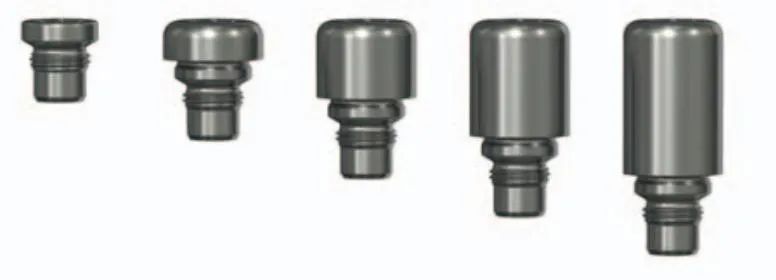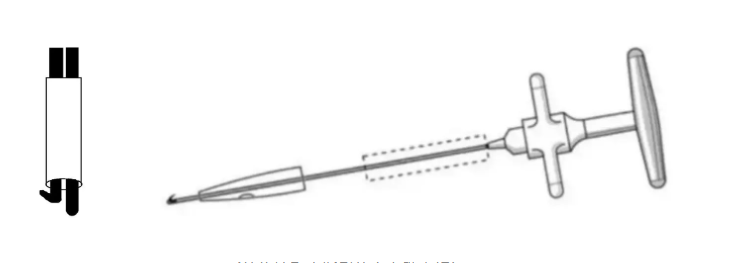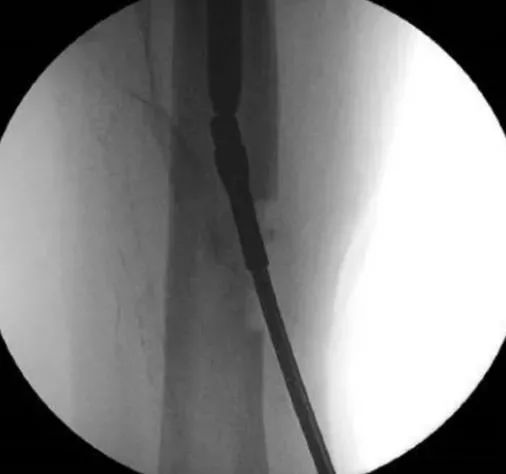Removal of intramedullary nails is a routine procedure, as each manufacturer provides appropriate removal tools. However, the actual need to remove the complete intramedullary nail is rare. Once the intramedullary nail ruptures, the situation becomes especially tricky. At this point, special instruments and techniques are required to remove the intramedullary nail.
Universal intramedullary nail removal and broken nail removal sets are available on the market, and these sets can help solve the above problems. However, blind surgery is not recommended without specialized tools.
The order in which the intramedullary nail is removed is critical. Before removing the internal fixation, the tail must be located and grasped. The tail cap is sometimes difficult to identify on X-rays, and for this reason, some physicians do not recommend using the tail cap unless it increases the working length of the intramedullary nail. After removing the tail cap, use the guide arm to grasp the intramedullary nail, and then proceed to the removal of the locking nail. It must be kept in mind that all locking pins must be removed before attempting to remove the main pin. If the manufacturer of the intramedullary nail cannot be identified, it is necessary to adequately expose the caudal end of the intramedullary nail to clarify its grasping mechanism, including thread type and size, and to select an appropriate extraction tool. If a perfect match is not possible, the option to use a tapered extraction tool may assist in grasping the tail of the intramedullary nail. If bone ingrowth into the nail hole or on the surface of the nail is suspected, the nail can be tapped inward a few millimeters with a sliding hammer before removal.
Various specifications of tail caps are designed to facilitate intraoperative selection and ensure intramedullary nail removal.

Several experienced physicians have summarized a large number of fractured intramedullary nail removal techniques. If the broken end of the fracture needs to be opened for cleaning and reduction, the intramedullary nail can be removed through the broken end. Below, we will briefly introduce some extraction methods that do not require exposure of the fractured end.
How to remove a broken cannulated intramedullary nail?
Usually, it is not very difficult to remove the proximal portion of the broken intramedullary nail. Once the proximal part is removed, it becomes a challenge how to remove the distal part without opening the fracture fragment. Reaming the proximal medullary canal by a few millimeters may facilitate distal nail removal.
Using a long nucleus or laparoscopic forceps, the distal portion can sometimes be grasped and successfully removed. However, long forceps do not provide a strong grip, and successful removal depends on whether the distal part has loosened.
Driving a thin intramedullary nail or a manual reamer into the distal broken nail also sometimes helps to remove it. During driving, the distal locking pin should be retained to avoid further displacement of the distal portion during driving. Once the thin intramedullary nail or manual reamer has achieved a firm engagement with the distal segment, remove the distal locking nail and then knock back to remove the broken distal segment.
Numerous literature reports on the use of hooked instruments to remove the distal portion of cannulated broken nails. The hollow cavity of the intramedullary nail can be filled with multiple guide wires in parallel along the direction of the extraction hook to avoid decoupling during the extraction process. The multiple guide wire packing technique is also sometimes an alternative to extraction hooks.

Finally, if all of the above proximal removal techniques are unsuccessful, distal removal of the intramedullary nail can be attempted. For example, a broken distal portion of the femoral intramedullary nail is removed through an opening in the distal femur through the knee joint. The drill is oriented toward the distal end of the intramedullary nail, and the opening is large enough to accommodate an olive-tipped guide wire with a gasket. The guide wire is retrogradely passed through the hollow of the intramedullary nail and protrudes from the opening of the proximal femur, and the olive head with the spacer can bring the distal broken nail out of the proximal femur. A similar technique can be used for the tibia, with a retrograde insertion of the distal opening of the guide wire at the medial malleolus. Sometimes, a Steiner's wire is inserted through the opening and knocked against the broken nail at the distal end, so that the broken nail can move a little proximally, which is helpful for retrograde insertion of the guide needle and removal of the broken nail.
How to remove a broken solid intramedullary nail?
Solid intramedullary nails are generally more difficult to remove than cannulated intramedullary nails. Its removal techniques include reaming of the proximal medullary cavity and effective grasping of the distal broken nail. Laparoscopic claw hooks can be used for the grasping of distal broken nails. The literature also reported a special grasping forceps around the tail of the nail. However, the use of various tools may not be able to effectively grasp the distal broken nail. In this case, the broken nail has to be knocked out from the other end of the bone. The technical principle is similar to that of the cannulated intramedullary nail. Use tools such as soft drills and hard guide pins to knock out the distal broken nails directly to the proximal end.

How to remove a broken interlocking intramedullary nail?
The head or proximal portion of an interlocking screw can usually be removed using the matching screwdriver. Sometimes the threads of an interlocking screw can slip within the bone, requiring traction around the head of the screw with forceps and a screwdriver to unscrew it. Damaged screw heads may require special tools for removal, such as internal fixation removal kits such as counter-threaded drills. The distal part of the broken screw is sometimes completely loosened, which does not affect the removal of the main screw, and can be left in the body if it does not affect the subsequent treatment operation. However, sometimes a broken distal nail can cause an iatrogenic fracture when the main nail is removed, and it is necessary to remove it. The most commonly used method is the push-out technique of the screw, that is, the main screw is withdrawn to its original position, so that the screw hole on the bone surface is in the same line as the locking hole of the intramedullary nail, and the broken screw is removed by using a Steiner's wire, a small malleus rod or a screwdriver. The pin is pushed out through the pin hole in the contralateral cortex and removed through a separate incision.
How to Buy Orthopaedic Implants and Orthopaedic Instruments?
For CZMEDITECH, we have a very complete product line of orthopedic surgery implants and corresponding instruments, the products including spine implants, intramedullary nails, trauma plate, locking plate, cranial-maxillofacial, prosthesis, power tools, external fixators, arthroscopy, veterinary care and their supporting instrument sets.
In addition, we are committed to continuously developing new products and expanding product lines, so as to meet the surgical needs of more doctors and patients, and also make our company more competitive in the whole global orthopedic implants and instruments industry.
We export worldwide, so you can contact us at email address song@orthopedic-china.com for a free quote, or send a message on WhatsApp for a quick response +86-18112515727.
If want to know more information,click CZMEDITECH to find more details.
English
Français
Русский
Español
العربية
Português
Deutsch
italiano
日本語
한국어
Nederlands
Tiếng Việt
ไทย
Polski
Türkçe
አማርኛ
ພາສາລາວ
ភាសាខ្មែរ
Bahasa Melayu
ဗမာစာ
தமிழ்
Filipino
Bahasa Indonesia
magyar
Română
Čeština
Монгол
қазақ
Српски
हिन्दी
فارسی
Kiswahili
Slovenčina
Slovenščina
Norsk
Svenska
українська
Ελληνικά
Suomi
Հայերեն
עברית
Latine
Dansk
اردو
Shqip
বাংলা
Hrvatski
Afrikaans
Gaeilge
Eesti keel
Māori
नेपाली
Oʻzbekcha
latviešu
অসমীয়া
Aymara
Azərbaycan dili
Bamanankan
Euskara
Беларуская мова
भोजपुरी
Bosanski
Български
Català
Cebuano
Corsu
ދިވެހި
डोग्रिड ने दी
Esperanto
Eʋegbe
Frysk
Galego
ქართული
guarani
ગુજરાતી
Kreyòl ayisyen
Hausa
ʻŌlelo Hawaiʻi
Hmoob
íslenska
Igbo
Ilocano
Basa Jawa
ಕನ್ನಡ
Kinyarwanda
गोंगेन हें नांव
Krio we dɛn kɔl Krio
Kurdî
Kurdî
Кыргызча
Lingala
Lietuvių
Oluganda
Lëtzebuergesch
Македонски
मैथिली
Malagasy
മലയാളം
Malti
मराठी
ꯃꯦꯇꯥꯏ (ꯃꯅꯤꯄꯨꯔꯤ) ꯴.
Mizo tawng
Chichewa
ଓଡ଼ିଆ
Afaan Oromoo
پښتو
ਪੰਜਾਬੀ
Runasimi
Gagana Samoa
संस्कृत
Gaelo Albannach
Sepeti
Sesotho
chiShona
سنڌي
Soomaali
Basa Sunda
Wikang Tagalog
Тоҷикӣ
Татарча
తెలుగు
ትግንያውያን
Xitsonga
Türkmençe
संस्कृत
ئۇيغۇرچە
Cymraeg
isiXhosa
ייִדיש
Yorùbá
isiZulu













